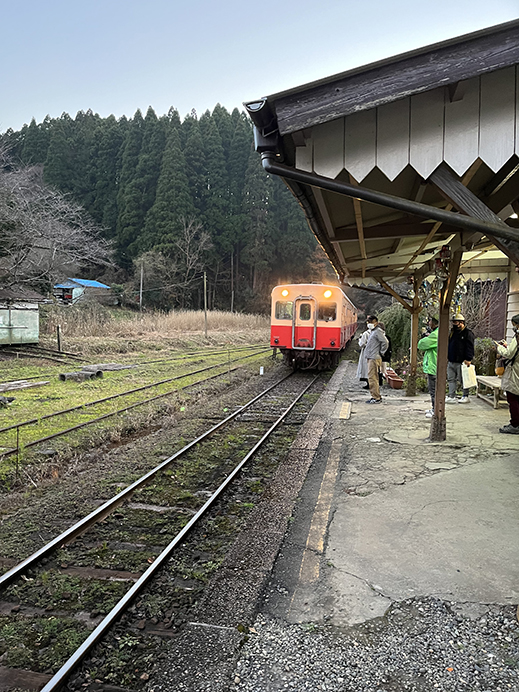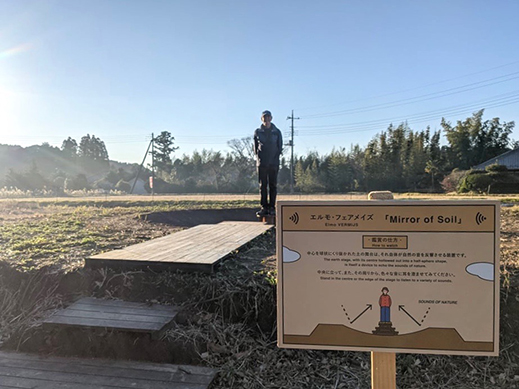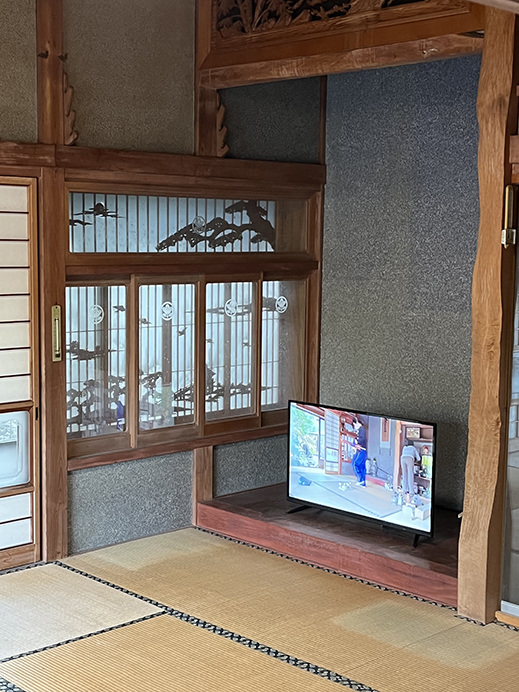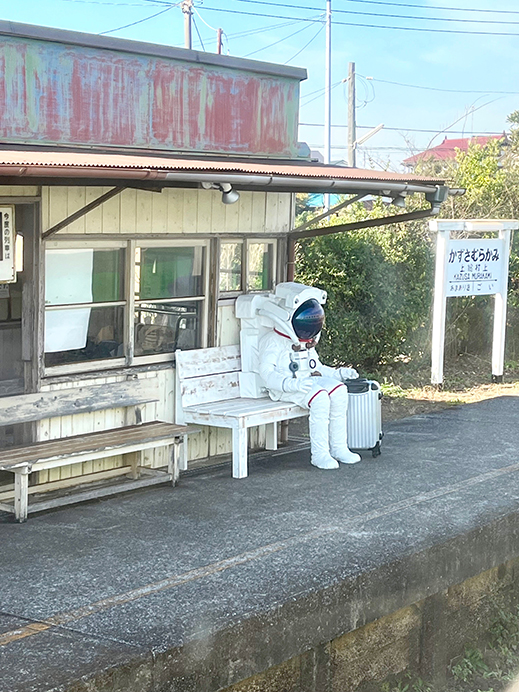| |
|
Here and There introduces art, artists, galleries, museums, and other cultural facilities around Japan that non-Japanese readers and first-time visitors may find of particular interest.
|
|
 |
|
|
 |
 |
Put Me on That Mystery Train: Ichihara Art x Mix 2020+
Alan Gleason |
 |
Mobile Photo Studio by Ma Leonn is decorated with a mishmash of ukiyo-e and prewar kamishibai art. Visitors can pose for a photo on the "stage" in the middle. |
"Art x Mix" may seem a curious title for the triennial art festival in Ichihara, Chiba Prefecture. However, the event does boast an unusual blend of elements that serve the art it showcases very well. One is the verdant, rolling landscape of the Boso Peninsula. But even more central to the festival's identity, and perhaps the key to its success, is a tiny privately operated train line, the Kominato Railway.
The festival is a fairly new event. First held in 2014, its third edition was scheduled for 2020 but delayed by a year due to the Covid pandemic. Sponsored by the city of Ichihara, the program itself is planned and directed by a team under Fram Kitagawa, Japan's reigning outdoor art festival impresario. His Tokyo gallery, Art Front, also manages regular exhibitions at the Ichihara Lakeside Museum, one of the hubs of festival activity.
|
 |
|
|
|
A two-car, two-tone Kominato Railway train arrives at Tsukizaki station at dusk.
|
Kitagawa et al. have built an empire of art biennales and triennales in scenic locations all over Japan, from Echigo-Tsumari in the hills of Niigata Prefecture to Setouchi on the islands of the Seto Inland Sea. What makes the Ichihara festival a standout among these is the Kominato Railway. Operating since 1917, the line is a living anachronism, a holdover from the days -- well into the postwar era -- when trains got everyone everywhere in Japan. As roads improved and rural areas emptied out in a mass migration to the cities, passengership plunged and, one by one, Japan's local railways shut down.
How has the Kominato Railway survived? At least partially thanks to the vision and marketing savvy of its management, it would seem. In the last decade the company has carried out what it calls "reverse development" of its stations, restoring them to their appearance in days of yore; enlisted the help of residents along the line to keep brush trimmed back and the station yards attractive; purchased used diesel rolling stock from closed lines in other parts of the country; and, in 2015, introduced the Satoyama Torocco (from "truck," a small rail car used in mining or logging). Satoyama, literally "villages and hills," is a buzzword the city and the railway favor to highlight the pastoral beauty of rural Ichihara. The Torocco is a special train outfitted with open-air passenger cars and a miniature steam locomotive that is actually a diesel. It runs once a day (twice on weekends) and has helped make the line a tourist draw, as well as a go-to location for filming commercials and dramas about rural life in a bygone era. It doesn't hurt that Ichihara is right across the bay from downtown Tokyo and less than an hour away by train.
|
 |
|
|
|
Itabu, an unmanned station on the Kominato Railway. The strings of lights provide festive illumination at night.
|
Ichihara Art x Mix is a brilliant initiative on the city's part, not least because it gives the Kominato Railway pride of place as an art object in itself. The trains -- at most two cars in length -- trundle slowly along a single narrow-gauge track at roughly one-hour intervals, making the 40-kilometer trip from Goi, on Tokyo Bay, up the Yoro River Valley to its southern terminus in the Boso highlands in one and a half hours. En route they pass through some of the loveliest terrain you will find anywhere within a 50-kilometer radius of Tokyo. Their trademark two-tone paint jobs of green or vermilion and cream apparently make them irresistible to trainspotters, who pop up with their cameras at frequent intervals along the line.
Many of the stations are unmanned and located seemingly in the middle of nowhere, often some distance from the nearest village. In a clever strategy to avoid hiring staff for each station, the company puts a conductor on every train who sells tickets on board. This was once the norm in Japan, but it's a sight that few people under age 50 are likely to remember. Indeed, the nostalgia quotient is so thick you could slice it, and the railroad is hyping it for all it's worth. So nicely have they maintained their infrastructure -- it appears frozen in time, specifically the 1950s (think Hayao Miyazaki's film Totoro) -- that the line recently won a Good Design Award from the Japan Institute of Design Promotion.
The other defining factor in the festival's allure is the Yoro River itself, which twists and turns its way through the highlands, carving deep ravines and creating some impressive cliffs and waterfalls in the bargain. The Yoro also gave birth to the area's latest tourist attraction: the "Chibanian," a rock formation discovered in the riverbank that provides evidence of the most recent reversal of the Earth's magnetic field. Just last year the discovery earned Chiba Prefecture naming rights to the geologic age following this dramatic event, which occurred around 780,000 years ago. Since one of the festival's art installations is right nearby, as is a shuttle bus stop, geology buffs may want to include a look at the Chibanian formation in their itinerary.
 |
|
Satoyama Shokudo, the cafeteria at the former Satomi Elementary School, serves simple but hearty fare inspired by school lunches of years past. The meals are a recent offering, part of volunteer activities associated with the Kominato Railway. |
So what about the art? you ask. Well, I was getting to that. In typical kitchen-sink festival fashion, the organizers have installed works all over the area -- far too many to see in a day, or even two or three. The appeal of the exhibits will vary with the beholder, of course, so you are duly advised to check out the festival website (much of which is in English) beforehand. You can also pick up the official guidebook at one of the visitor centers set up on-site. Poring over these resources in advance and picking out a few destinations with works that look intriguing to you is, I think, the only way to avoid feeling overwhelmed by the options.
Getting to them, however, is another story. A car is certainly the most efficient mode of transport, but also the least rewarding. The train is a pleasure in itself, but its sparse schedule, and the distance between the stations and many art venues, will limit the number of destinations you can easily get to. A good compromise is the festival's free shuttle bus, which travels around two circuits that cover most of the major venues.
 |
|
The former gym at Satomi Elementary School (the building to the right of the cafeteria in the photo above) houses Artists Breath Playback, an attractively designed abridgement of a recent show at the Ichihara Lakeside Museum. |
Determined to use the train and my own feet as much as possible, I mapped out a route that would allow access to a sample of (hopefully) rewarding exhibits in a variety of locations, all within walking distance of two or three stations. This plan more or less worked out, but involved a fair amount of hiking, sometimes on busy roads with no sidewalks, and at least one desperate dash to catch the shuttle bus and avoid a half-hour wait for the next one. Other festivalgoers seemed content to use the bus or their own car. Even with those self-imposed limitations, though, most of the works I saw were worth the trek. Here are some personal highlights:
Ushiku: The only town of any size along the Kominato Railway, Ushiku serves as a de facto gateway to the festival. Across from the station is a visitor center where you can purchase an all-day festival passport (3,000 yen), pick up maps and brochures, and generally get your bearings. Close by is the town's compact business district, where some well-preserved old storefronts have been converted into temporary galleries. In a copper-cladded former sundries shop, Chinese artist Ma Leonn's Mobile Photo Studio has a hilariously retro stage set inspired by prewar kamishibai ("paper play") storytellers; staff will kindly photograph visitors posing against this backdrop.
 |
|
Elmo Vermijs's installation Mirror of Soil, excavated from a rice field outside Tsukizaki Village. A sign explains how it works. The writer can testify that it does. |
Satomi Elementary School: The school closed in 2013 but has been maintained as a community center ever since. During the festival it is hosting several large installations as well as a café, Satoyama Shokudo, that serves tasty homestyle dishes. The dark, cavernous gymnasium is the perfect setting for a "playback" of Artists Breath, a tour-de-force display of multiple videos with corona-related messages by artists from around the world. The original show took place earlier this year at the Ichihara Lakeside Museum (for a review, see the June 2021 Here and There). If anything, Satomi's digest version is more imaginatively designed. Standing at the center of the school's basketball court, one is surrounded by a dozen or more gauze screens hung from the high ceiling, each one projecting a different video. The gauze allows the images to pass through and reflect a second time off the gym walls, right under the basketball nets.
|
 |
|
|
|
In Inventory, an installation by Ayse Erkmen that occupies a vacated residence in Tsukizaki Village, a different video playing in each room shows project staffers removing items from the same spot. This monitor sits in a tokonoma alcove that used to contain a scroll and several vases.
|
Tsukizaki Village: Sitting in the middle of a fallow rice field is Dutch artist Elmo Vermijs's cryptically titled installation Mirror of Soil. But that is precisely what it is: a shallow concave hemisphere scooped out of the ground that functions as a "sound mirror." Stand on the raised platform smack in the center of the pit, and it's true -- you will hear a faint murmur you did not hear before, which the artist describes as the "sounds of nature."
Just down the road stands an imposing edifice, the now-vacant residence of one of the village's more eminent citizens. Currently it is home to Turkish artist Ayse Erkmen's installation Inventory. Erkmen videotaped the process by which the entire contents of the house -- not just furniture, but decades of accumulated bric-a-brac -- were removed, sorted, and placed in wire crates that now line the path from the gate to the house. Running this gauntlet of family heirlooms, one encounters everything from wall clocks and electric fans to old swords, stuffed birds, dolls, and souvenirs of the kind that all postwar families of means used to acquire on holiday excursions. The experience will give anyone who has lived in Japan a twinge of nostalgia; we all have friends whose parental homes were full of just this sort of stuff. Inside the house, the artist has placed video monitors in each room that play back her recordings, striking a poignant contrast between the on-screen activity and the silence of the emptied rooms.
 |
|
 |
|
|
|
Two of Sou Fujimoto's series of delightfully weird station toilets: Toilet in Nature at Irabu (left) and Satoyama Toilet at Kazusa-Ushiku (right). |
The ancient but well-preserved stations along the Kominato Railway are also part of the fun. Each one features at least one prominent outdoor art object, and one extremely eccentric public toilet. The toilets are the brainchild of architect Sou Fujimoto, who appears to have thoroughly enjoyed himself designing facilities customized to the ambience of each stop. Kudos go to Itabu station's Toilet in Nature, a pristine white throne that sits in a glass box surrounded by a 200-square-meter garden. It's for women only, by the way. Privacy is ensured by a curtain and the 2-meter-high log fence around the garden. Kazusa-Ushiku station boasts a veritable gallery of toilets by Fujimoto, each with its own unique design. Once again it is a women's toilet that gets the prize for the ikebana-like arrangement of maple saplings that grow up through a hole in the roof.
Greeting every train at Kazusa-Murakami -- an unmanned station that is the first and last stop on the line just outside the Goi terminus -- is Russian artist Leonid Tishkov's astronaut. The space-suited figure sits patiently on a bench, suitcase in hand, awaiting his ride to the next galaxy, perhaps. He's the perfect doorman to the alternate universe that is the Yoro Valley for the duration of Ichihara Art x Mix.
 |
|
This astronaut greets passengers at Kazusa-Murakami station on their way to and from the festival area. Leonid Tishkov titled his installation Mr. Murakami's Last Flight, or Waiting for A Moon-Bound Train. |
All photographs by Alan Gleason and Kaoru Moriyama.
|
 |
| Ichihara Art x Mix 2020+ |
| 19 November - 26 December 2021 |
Various stations along the Kominato Railway, Ichihara City, Chiba Prefecture
Access: From Tokyo, take the JR Sobu Line to Chiba, transfer to the JR Uchibo Line to Goi, and transfer to the Kominato Railway.
|
|
|
|
| |
 |
Alan Gleason
Alan Gleason is a translator, editor and writer based in Tokyo, where he has lived for over 30 years. Since 2006 he has edited artscape Japan and written the Here and There column, as well as translating the Picks reviews. He also edits and translates works on Japanese architecture, music, and theater. |
|
|
|
|
|
|
|
|
|
 |
|